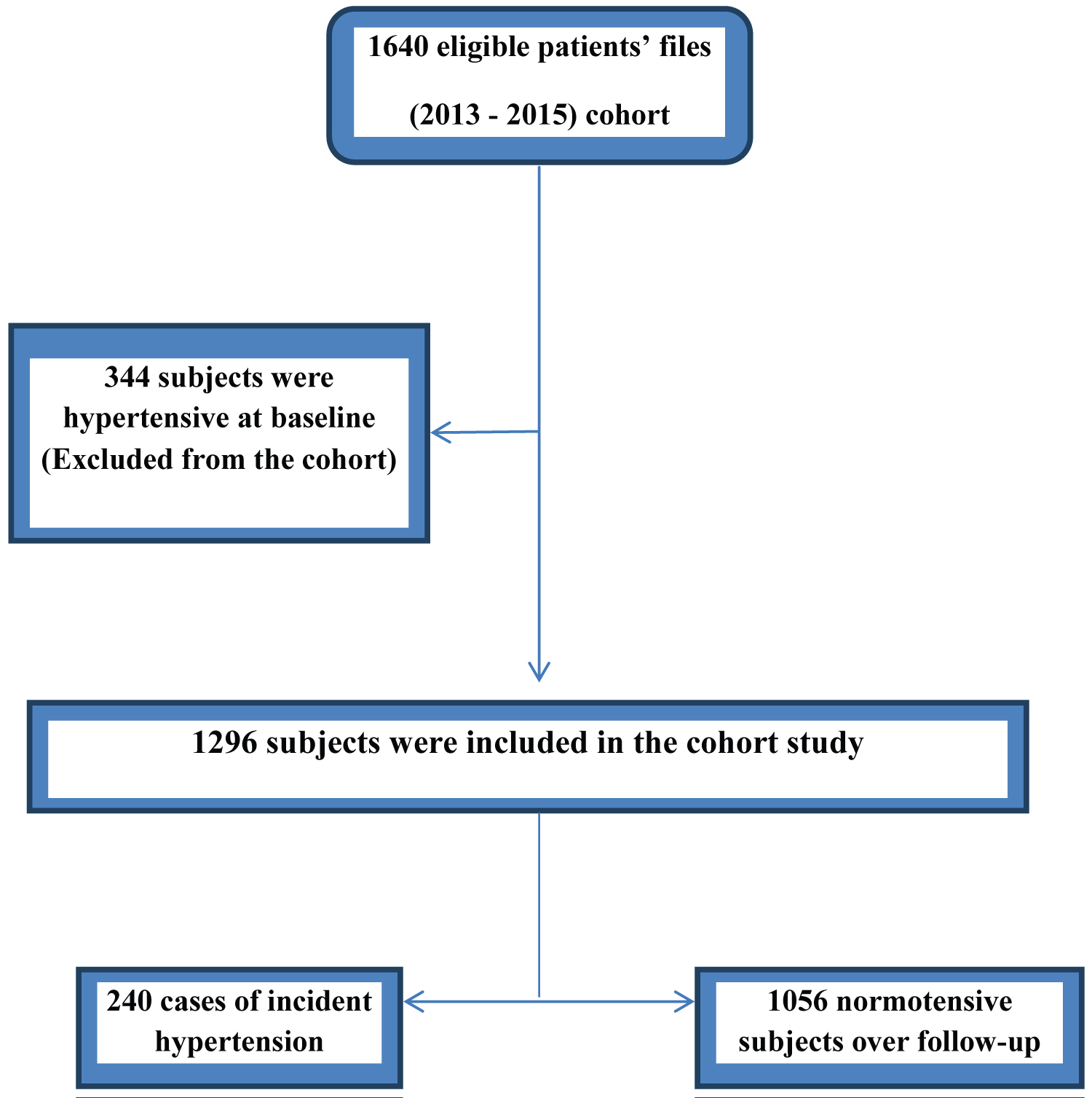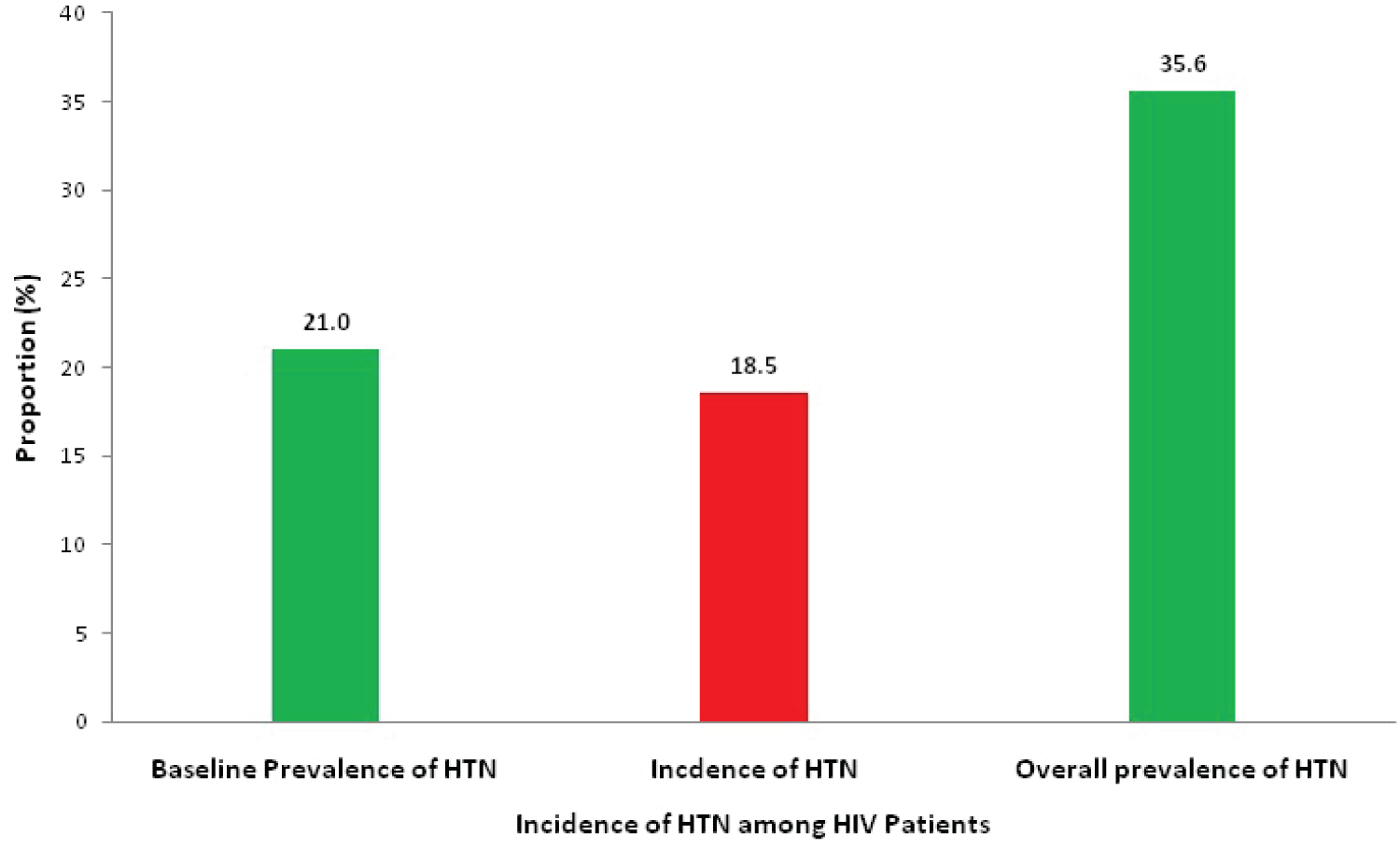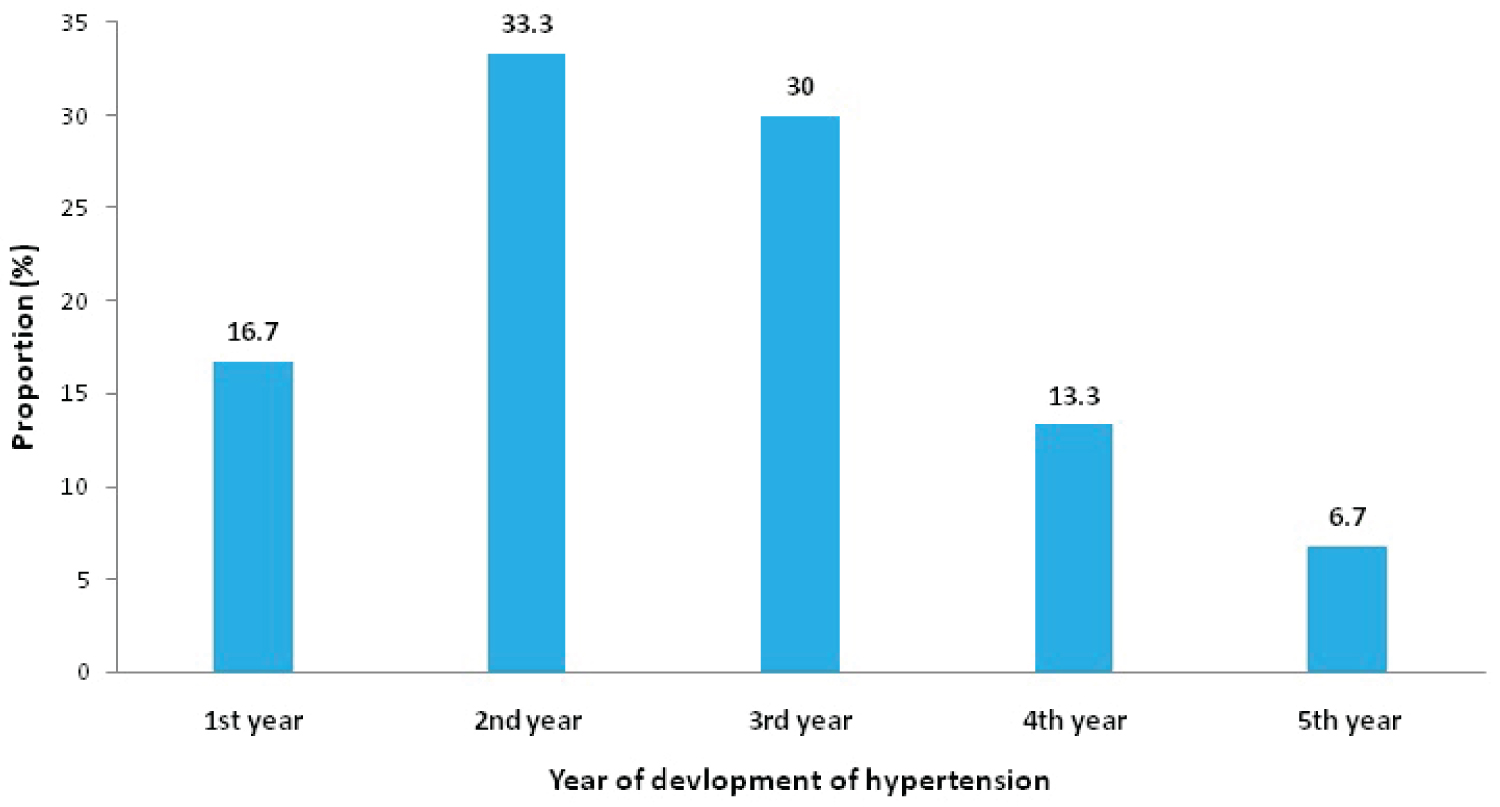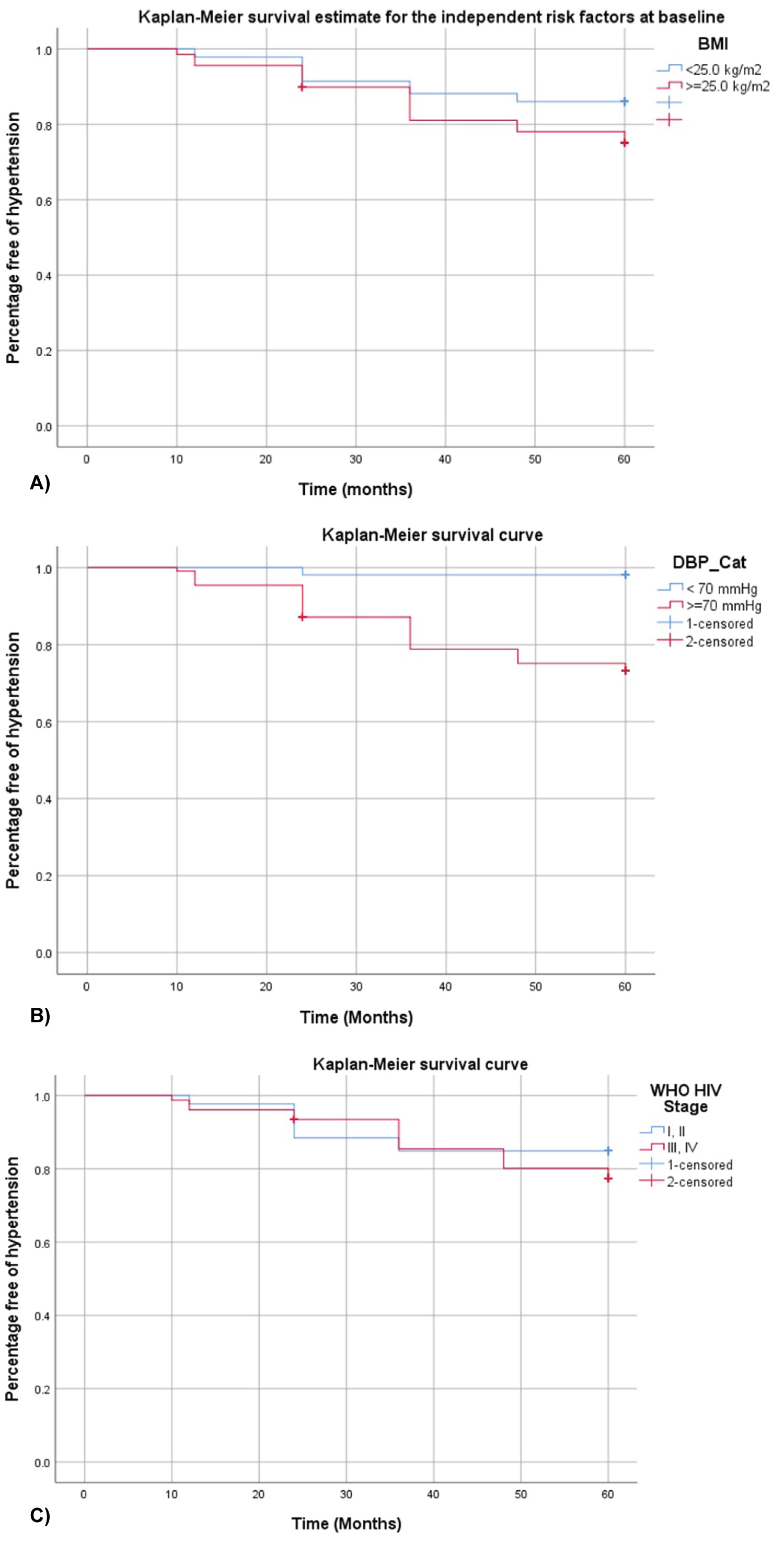Background: Hypertension has reached epidemic proportion among people living with HIV (PLHIV) and this could have a negative bearing on the quality of life and survival of these patients.
Aim: The aim of this study was to determine incidence and associated risk factors of hypertension among HIV patients on antiretroviral therapy (ART) in Fako Division, South West Region of Cameroon.
Methodology: A 5-years retrospective cohort study was used to review the records or patient files of 1640 HIV patients enrolled between the years 2013-2015. These files were reviewed in 3 HIV treatment Centers which measured a recorded blood pressure routinely. Data was entered in SPSS 25 and analyzed using stata 13. Log rank test and cox proportional hazard regression were used to identify independent risk factors. Statistical significance was set at p < 0.05.
Results: Among 1640 ART-naïve, eligible subjects, 344 (21.0%) were hypertensive at recruitment. The remaining 1296 individuals contributed 2200 person-years during the 5 years of follow-up and 240 (18.5%) of them developed hypertension during a mean time of 24.3 months (SD = 4.6). This gave an incidence rate 109.1 cases/1000 person-years, 95% (CI) 102.9-118.3]. Cox regression models identified body mass index (aHR: 1.12, 95% CI 1.05-1.17, p < 0.001), Diastolic Blood Pressure (aHR: 1.09, 95% CI 1.05-1.14, p < 0.001) and WHO HIV stage (aHR: 1.71, 95% CI 1.02-2.75, p = 0.029) as independent risk factors for hypertension development.
Conclusions: The prevalence and incidence of hypertension were high in our cohort. Traditional cardiovascular risk factors and WHO HIV clinical stage predicted incident hypertension, but no association was observed with immunological or ART regimen. These data support the implementation of routine hypertension screening and integrated management into HIV program in rural Sub-Saharan Africa and equally the early initiation of patients on ART through the UTT approach.
Incidence, Risk factors, Hypertension, Retrospective cohort, HIV, ART, Fako division
AIDS: Acquired Immuno-deficiency Syndrome; ART: Anti-retroviral Therapy; COVID-19: Coronavirus Disease 2019; CVDs: Cardiovascular Diseases; HTCs: HIV Treatment Centers; HIV: Human Immunodeficiency Virus; LMIC: Low- and Middle Income Countries; NCD: Non-Communicable Disease; PLWH: People Living With HIV; SBP: Systolic Blood Pressure; BMI; Body Mass Index; VL: Viral Load; SWR: South West Region; SSA: Sub-Saharan Africa; UTT: Universal Test and Treat; WHO: World Health Organization
The burden of non-communicable diseases (NCD) and their modifiable risk factors is on the rise in Sub-Saharan Africa (SSA). Among people living with HIV (PLHIV), epidemiological studies have revealed a trend of increasing prevalence of four major risk factors of NCDs; hypertension, hyperglycemia, dyslipidemia and obesity [1-3]. With the increasing availability of antiretroviral therapy (ART), the ageing HIV population is susceptible to traditional risk factors for NCDs. Furthermore, both the HIV virus and prolonged ART use have been associated with dyslipidemia, insulin resistance, and atherosclerosis, interacting with traditional risk factors to increase the risk of NCDs among PLHIV [3,4]. The increased NCDs risk among PLWH has the potential to threaten the success of ART use, causing morbidity, poor quality of life and premature mortality.
The prevalence of HIV in Cameroon was 3.9% in 2015 [5]. The World Health Organization (WHO) estimates for deaths attributed to Non-Communicable Diseases (NCD) in Cameroon was 35.0% in 2018 [6]. The prevalence of HIV is 3.6% and that of hypertension is 31.1% in the South West Region (SWR) of Cameroon [2,5]. The prevalence of hypertension (38.0%) and dyslipidemia (51.0%) in HIV patients on ART have reached epidemic levels in Fako Division, SWR of Cameroon [2,3]. Fako Division as well as the other fast urbanizing divisions in Cameroon is experiencing a double burden of HIV and NCDs. Although evidence from high-income countries is definitive as to the emerging importance of NCDs in PLHIV, there are far fewer data and research advances regarding such conditions in low and middle income countries (LMICs).
Rapid changes in lifestyle, together with a hypertension-prone genetic background in black Africans, are leading to the unfolding of a hypertension epidemic of presumably distinct characteristics from those observed outside the continent [7]. Indeed, age-adjusted prevalence of hypertension in the region have already reached the highest levels in the world with an estimated prevalence of 30% [2,3]. While there is consensus in the field about the increased risk of cardiovascular events among HIV patients, the relation of hypertension with HIV infection and ART remains controversial. Indeed, inconsistent and often contradictory reports of associations between HIV infection, ART exposure, specific antiretroviral drug regimens and HIV-related factors have been successively reported in the literature [8]. Interestingly, some widely used antiretroviral drugs have been linked to renal and cardiovascular adverse effects (i.e. tenofovir disoproxil fumarate [TDF] and nephrotoxicity; abacavir [ABC] and myocardial infarction), but their relevance in the hypertension scenario is not well defined [9,10]. This degree of uncertainty on the burden and epidemiology of hypertension is even higher for sub-Saharan African HIV populations, where only a limited number of studies have approached the subject from a mostly cross-sectional perspective. Thus, unraveling the epidemiology of hypertension among HIV patients in sub-Saharan Africa stands out as an urgent task, and could potentially set the ground for a more optimal clinical management. In this context, our study aimed to explore the prevalence, incidence and risk factors of hypertension development among adult HIV patients on ART in Fako Division, Cameroon.
For administrative approval, the study protocol was read and approved by South West Regional Delegation of Public Health and heads of the health facilities hosting the HTCs. Ethical clearance was obtained from the Faculty of Health Science Institutional Review Board, University of Buea, Cameroon.
The study was a 5-years retrospective cohort involving the records and patient files of HIV patients receiving ART (2013-2015 cohorts) in Fako Division, SWR of Cameroon.
The study was carried out in 3 high-patient load HIV treatment centers in Fako Division that screen and record blood pressure routinely (Figure 1). These hospitals are specialized HIV treatment centres that provide free anti-retroviral therapy in addition to HIV counseling and testing services. According to the RTG of the Regional Delegation of Public Health for the South West Region report for 2020, a total of 18,000 HIV patients were receiving treatment in Fako Division [11]. Patients report every 1, 3 and 6 months for antiretroviral therapy refill depending on the availability of drugs. The number of HIV patients on ART has seen a hick because most patients have been transferred-in from the highly hit conflict areas to Fako Division which is relatively safer. The patients who attend the facility are of different socio-economic statuses. Information on NCDs is not collected in routine care at the facility during patient visits. Hypertension is sometimes screened for at every clinic visit, diabetes mellitus II, asthma, cardiomyopathy and osteoporosis are usually screened for when a patient complains of certain symptoms during the routine follow up visits. Renal impairment is screened for among patients upon being started on tenofovir based regimen. However, some NCDs are screened for as a result of participation in research projects that require screening for certain ailments/medical conditions.
 Figure 1: Map of Fako Division showing HIV Treatment Centers.
View Figure 1
Figure 1: Map of Fako Division showing HIV Treatment Centers.
View Figure 1
The targeted population was HIV patients aged ≥ 18 years. Their records and patient files were equally reviewed.
Records and patient files of ART-naive subjects (aged 18 years and above who had been initiated on ART between 2013-2015) at baseline with at least 2 registered refills or consultation sessions within 6 months since recruitment were included. Only patients aged 18 years and above.
Records and patient files of HIV patients on transit from other healthcare facilities were excluded. Records of pregnant women during the study period were not included in the analysis due to known effects of pregnancy on physiological parameters.
Incident hypertension was defined as systolic blood pressure (SBP) ≥ 140 mmHg and/or diastolic blood pressure (DBP) ≥ 90 mmHg on 2 consecutive visits. Subjects with recorded previous history of hypertension and those with SBP ≥ 140 mmHg and/or DBP ≥ 90 mmHg on the first 2 blood pressure measurement sessions within 6 months since registration were classified as hypertensive at baseline.
Demographic, clinical and treatment data was anonymized and extracted from HIV patients' records or booklet. We abstracted data from all adult patients who initiated ART in the Limbe Regional Hospital and the CDC Central Clinic between January 1st, 2013 and December 31st, 2015 and had a minimum of two clinic visits. We obtained data patient data including: Age, gender, height, weight, and blood pressure at each visit, ART regimen history and CD4 T-lymphocyte (CD4) count history. Other laboratory tests, including serum creatinine, glucose and lipid measurements, were not consistently available at the clinic. These were only present for less than 1% of the cohort, and therefore were excluded from this analysis.
At each clinic visit, a trained nurse performed and recorded blood pressure measurements of seated patients using a calibrated aneroid sphygmomanometer, with small (< 21 cm) and normal (22-32 cm) cuff sizes. Patients were seated in a chair and rested for approximately 10 minutes before BP was measured. Following initial BP measurement, patients with SBP > 140 mmHg and/or DBP > 90 mmHg during this screen underwent two repeat BP measurements one minute after. The average of the two later BPs would then be recorded in the patients clinic review form. Weight and height are measured using a stadiometer attached to a weighing scale. Height was measured to the nearest 0.1 cm after removal of shoes. Weight was measured to the nearest kilogram after removal of shoes and heavy clothing. Data were entered directly into an electronic database (Excel spreadsheet).
The blood pressures of the HIV patients were abstracted from their patient files from the time of initiation to exactly 5 years. The blood pressures were monitored and the time of hypertension recorded for participants who developed hypertension. Participants who did not develop hypertension were censored.
All data management and statistical analyses was conducted in Stata 13 and Epi info 7. Univariate analysis was performed to determine the baseline prevalence and incidence of hypertension. Log rank test was used to establish the association between individual risk factors and hypertension. Multivariate Cox proportional hazards models was fitted to assess the association of the time to develop hypertension with demographic, clinical and treatment covariates. The analysis was based on the intention to treat approach.
The mean age at initiation to ART was 41.3 years (SD = 7.3), 62.0% of participants were female. Mean baseline CD4 count was 248.4 cells/μL (SD = 11.5) and 26.8% of patients were in WHO HIV stage IV. Obesity (Body Mass Index ≥ 30 kg/m2) at enrolment was reported in 8.3% of individuals. The single tablet, co-formulated combination of tenofovir disoproxil fumarate (TDF), lamivudine (3TC) and efavirenz (EFV) or tenofovir disoproxil fumarate (TDF), lamivudine (3TC) and Delutegravir (DLT) was the most common first-line ART regimen (95.6%). Alcohol consumption (44.4%) and smoking (10.2%) was common among the subjects on initiation to ART. Table 1 summarizes the baseline characteristics of the patients included in the retrospective cohort analysis.
Table 1: Baseline characteristics of subjects followed-up for incident hypertension (n = 1640). View Table 1
Of the 1640 files reviewed in the retrospective cohort study, 344 subjects met the definition of hypertension at baseline, corresponding to a prevalence of 21.0% (95%CI: 17.3-23.9). The remaining 1296 individuals contributed 2200 person-years (p-m) during the 5 years study period, with a mean time of 2.91 years (SD = 1.01) of follow-up and a mean number of clinical visits of 12.0 (SD = 3.4). Of these 1296 subjects followed for 5 years, 240 (18.5%) developed hypertension during follow-up (incidence density rate 109.1 cases/1000 person-years [p-y] [95% CI: 102.9-118.3]) after a mean time of 24.3 months (SD = 4.6) after enrolment. One hundred (6.1%) patients were lost to follow-up, 60 (3.7%) were transferred to other centres and 24 (1.5%) died without having developed hypertension. The analysis was based on the intention to treat approach. The flow chart of the participants is shown on Figure 2.
 Figure 2: Flow chart of the participants during the retrospective cohort. View Figure 2
Figure 2: Flow chart of the participants during the retrospective cohort. View Figure 2
Overall, of the 1640 participants' files reviewed for hypertension, 584 (344 at baseline and 240 at follow-up) had hypertension, giving a prevalence of 35.6% (95%CI: 31.8-39.5) as shown on Figure 3.
 Figure 3: Incidence and prevalence of hypertension in the retrospective cohort.
View Figure 3
Figure 3: Incidence and prevalence of hypertension in the retrospective cohort.
View Figure 3
Of the 240 cases of incident hypertension recorded during the 5-years follow-up period, majority 80 (33.3%) and 72 (30.0%) were recorded in the 2nd and 3rd years of follow-up respectively (Figure 4).
 Figure 4: Proportion of incident hypertension as a function of years of follow-up.
View Figure 4
Figure 4: Proportion of incident hypertension as a function of years of follow-up.
View Figure 4
BMI (aHR: 1.12, 95% CI 1.05-1.17, p < 0.001), DBP (aHR: 1.09, 95% CI 1.05-1.14, p < 0.001) and WHO HIV stage (aHR: 1.71, 95% CI 1.02-2.75, p = 0.029) were identified as independent risk factors of incident hypertension in our adjusted Cox Proportional regression model (Table 2). In addition, a non-significant trend was observed towards an association of age (aHR: 1.01, 95% CI 0.98-1.29, p = 0.065) and alcohol consumption (aHR: 0.61, 95% CI 0.43-2.13, p = 0.078) with higher and lower incidence of hypertension respectively. Neither baseline CD4 count (aHR: 0.91, 95% CI 0.72-2.01, p = 0.201) nor family history of hypertension (aHR: 1.50, 95% CI 0.93-3.64, p = 0.129) were associated with the development of hypertension in our cohort.
Table 2: Cox regression analysis of risk factors for hypertension development. View Table 2
Kaplan-Meier estimates for the probability of remaining free of hypertension by the three independent risk factors are displayed in Figure 5a, Figure 5b and Figure 5c. The survival curves show a higher proportion of observed hypertension events during the study period among those subjects with baseline BMI ≥ 25 kg/m2 (24.6% versus 13.9% for BMI < 25 Kg/m2; log rank p < 0.001), DBP ≥ 70 mmHg (26.7% versus 1.9% for DBP < 70 mmHg; log rank p < 0.001) and WHO HIV Clinical stages III-IV (22.4% versus 15.1% for WHO HIV Clinical stage I-II; log rank p = 0.002). Baseline CD4 count, age, SBP, alcohol consumption and family history of hypertension were associated with the development of hypertension in our cohort.
 Figure 5: (a) Kaplan-Meier survival estimates of hypertension development according body mass index; (b) Kaplan-Meier survival estimates of hypertension development according diastolic blood pressure; (c) Kaplan-Meier survival estimates of hypertension development according WHO HIV clinical stage.
View Figure 5
Figure 5: (a) Kaplan-Meier survival estimates of hypertension development according body mass index; (b) Kaplan-Meier survival estimates of hypertension development according diastolic blood pressure; (c) Kaplan-Meier survival estimates of hypertension development according WHO HIV clinical stage.
View Figure 5
This retrospective cohort study is among the few to assess the incidence of hypertension in a broadly inclusive population of HIV-positive subjects recruited into care in a sub-Saharan African setting. Key findings were the 21.0% prevalence of hypertension at recruitment, the 18.5% incidence of hypertension during a 5 years follow-up period, the association of well-known traditional cardiovascular risk factors with incident hypertension, and the lack of association of incident hypertension with baseline CD4 counts or ART status.
As ART program are globally scaled-up and AIDS-related deaths are reduced across developing countries, the management of non-communicable co-morbidities such as hypertension is emerging as an essential part of HIV care in resource-limited settings. Yet, longitudinal data on incident hypertension in HIV patients in sub-Saharan Africa are largely lacking. In the present study, we found both a high prevalence at recruitment (21.0%) and a high incidence of hypertension among patients initiating HIV care in Fako Division, South West of Cameroon.
Two hundred and forty (18.5%) developed hypertension over a 5 years period of retrospective cohort follow-up (4.51 years), leading to an estimated incidence rate of 109.1 cases/1000 p-y (95% CI: 102.9-118.3). These results are similar to those recently reported in a similar study restricted to patients on ART in rural Uganda (111.5 cases/1000 p-y, 95% CI: 101.9 ± 121.7) and Tanzania (120 cases/1000 p-y, 95%CI: 97-150) [12,13]. Our value for incidence density rate was higher in magnitude than estimates described among PLWH in Norway (29.8 per 1000 p-y, 95% CI 20.3-40.2) and the USA (72.1 per 1000 p-y, 95%CI 68.0-76.3), suggesting a higher incidence of hypertension among people living with HIV in rural sub-Saharan Africa [11].
The overall prevalence of hypertension among HIV patients in Fako Division was 35.6% (95%CI: 31.8-39.5) which is in line with the 38.0% obtained in the Limbe Regional Hospital [2,3]. Well-known cardiovascular risk factors such as BMI, SBP and clinical factors (WHO HIV stages) were confirmed as strong risk factors of incident hypertension among HIV patients initiated on ART in Fako Division. The impact of HIV- or ART-specific hypertension risk factors in the HIV patient population remains a controversial issue, with conflicting results reported in different settings [14]. While having been linked by several studies to an increased risk of hypertension, ART exposure has been also associated with decreased odds of hypertension in a large South African population-based survey.
In our cohort, we did not find any association between hypertension and baseline CD4 count or ART exposure. ART regimens based on the single tablet triple combination of TDF/(3TC or FTC)/EFV, with only marginal numbers exposed to other antiretroviral drugs. This distribution of ART regimens in our cohort precluded a comprehensive analysis of whether exposure to specific antiretroviral drugs was associated with an increased risk of hypertension. Noteworthy, a recent analysis from the D:A:D (Data Collection on Adverse Events of Anti-HIV drugs) study failed to find any clinically relevant independent association between exposure to individual ART drugs and hypertension [15]. ART effects on body mass or immune reconstitution have been proposed as potential drivers of increased hypertension risk among HIV patients [15]. Also, exposure to TDF has been associated with accelerated eGFR decrease in the first 6 ± 12 months after ART initiation among African HIV patients with no or mild renal dysfunction at baseline [16]. Although the reported overall effects were modest, the possible impact of secondary nephrotoxicity on hypertension rates deserves consideration given the large proportion of patients receiving TDF-based ART in our cohort. Overall, our results are consistent with those of prior studies showing a remarkably elevated risk of hypertension among HIV patients and individuals of African ancestry and support universal hypertension screening strategies regardless of baseline CD4 count or ART exposure.
Though our study did not find a direct association between incident hypertension and immunological parameters (such as CD4 and VL), WHO clinical staging for HIV/AIDS was statistically significantly associated with incident hypertension. These results go a long way to reinforce the need to initiate ART during the early stages of infection as this those not only significantly improves health outcome (by suppressing VL) but reduces the risk of hypertension in adult HIV patients.
This study has some limitations. The lack of an HIV-negative control group hinders our ability to examine the impact of HIV infection on hypertension. It therefore remains uncertain whether and to which degree the high observed incidence in our cohort may be reflecting population-wide disease trends. In this context, data from several studies have suggested that HIV infection could be associated with lower hypertension prevalence and decreased blood pressure with respect to uninfected individuals, an effect that appears to be only partially mediated by BMI changes [8,17,18]. Although measurement bias of hypertension events was minimized by the definition requirement of two consecutive abnormal BP values, the non-availability of data on concurrent antihypertensive drug treatment may have led to non-differential misclassification and underestimation of the incidence of hypertension. Also, relevant variables such as serum lipid levels, HIV viral load, or use of traditional medications potentially contributing to hypertension were not routinely ascertained during clinical practice and could not be incorporated into our regression analyses. Lastly, LTFU and transfer to other clinics were frequent events during follow-up and may complicate the interpretation of our results. The hereby reported high patient drop-out rates could be explained in the context of restricted access to the hospital facilities during the rainy season due to impaired communications, and common continuation of HIV care in non-referral clinics, usually closer to the patients' place of residence. Despite these drawbacks, our study provides significant new insights into the epidemiology of hypertension in rural sub-Saharan Africa and has important implications for public health program in the region.
Health systems in sub-Saharan Africa are expected to face an unprecedented epidemic of both communicable and emerging chronic diseases in the near future [19]. This double burden of disease will arguably represent a major strain for still under-resourced health services across the continent. Hypertension and other non-communicable diseases share a number of similarities with HIV, such as the chronic evolution of disease, the importance of behavioural changes and the need for regular follow-up and optimal treatment adherence, which make them attractive for an integrated management approach. Leveraging synergies between HIV and non-communicable diseases care without compromising the efficiency of HIV program is one of the challenges lying ahead. This study has shown that the implementation of routine hypertension screening represents a feasible strategy for hypertension diagnosis within an HIV rural program. Likewise, further research that evaluates the outcomes of interventions promoting hypertension treatment and control among HIV patients recruited into HTCs in Fako Division is warranted. Encouragingly, the integration of HIV, hypertension and diabetes management at chronic diseases clinics in Cambodia has already resulted in efficiency gains for the services, good patient acceptance and favourable HIV clinical outcomes [20]. Expanded access to antihypertensive drugs will be essential, however, if similar integrated HIV program are to be successful in sub-Saharan African settings.
Baseline prevalence and incidence of hypertension among adult HIV patients on ART in Fako Division was high. Baseline traditional cardiovascular risk factors (BMI and SBP) and clinical risk factors (WHO clinical stages of HIV) were associated with incident hypertension among adult HIV patients on ART, but no association was observed with baseline immunological status and ART type.
These data support the implementation of universal routine hypertension screening for HIV patients and highlight the need for the incorporation of evidence-based non-communicable diseases management strategies into integrated HIV program in rural Sub-Saharan Africa.
The study was based on secondary data whose quality and completeness is usually inadequate. Our limited sample was partly due to the fact that many file record were excluded for lack of complete follow-up data.
The strength of this study was that it made use of a retrospective cohort design which has a stronger potential of establishing causality than the cross-sectional design.
We recommend further studies to develop and validate risk prediction model for incident hypertension among HIV patients on ART in Fako Division.
This study was self-funded.
The data that support the findings of this study are available from the corresponding author upon reasonable request.
TAY, ALN, NFP and EOG designed the study. TAY, NEN, NSA and KEN did the fieldwork. TAY and TN did the analysis. TAY wrote the first draft, and all authors approved the final version.
The authors declare that they have no competing interests.
This manuscript does not contain any individual's data. Consent for publication was obtained from the PhD thesis supervisors.
This study was approved for exemption by the Faculty of Health Sciences of the Institutional Review Board at University of Buea.